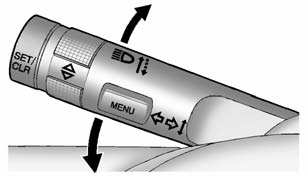Chevrolet Sonic Owner's Manual: Turn and Lane-Change Signals

Move the lever all the way up or down to signal a turn.
An arrow on the instrument cluster will flash in the direction of the turn or lane change.
Raise or lower the lever until the arrow starts to flash to signal a lane change. Hold it there until the lane change is completed. If the lever is briefly pressed and released, the turn signal flashes three times.
The lever returns to its neutral position when it is released.
If after signaling a turn or lane change the arrow flashes rapidly or does not come on, a signal bulb may be burned out. Replace any burned out bulbs. If a bulb is not burned out, check the fuse. See Fuses and Circuit Breakers or Bulb Replacement.
Turn Signal On Chime
If the turn signal is left on for more than 1.2 km (0.75 mi), a chime will sound at each flash of the turn signal. To turn the chime off, move the turn signal lever to the neutral position.
 Hazard Warning Flashers
Hazard Warning Flashers
(Hazard Warning Flasher): Press
and momentarily hold this button to make the front and rear turn signal lamps flash
on and off. This warns others that you are having trouble. Press and momentar ...
 Fog Lamps
Fog Lamps
For vehicles with front fog lamps, the button is on the outboard side of the
instrument panel.
The ignition must be on to turn on the fog lamps.
(Fog Lamps): Press to turn the
fog lamps on or ...
Other materials:
Body Waterleak Repair
Warning: If the vehicle interior is exposed to moisture and becomes
soaked up to the level of the sensing and diagnostic module (SDM), the SDM and
SDM harness connector must be replaced. The SDM could be activated when powered,
which could cause airbag deployment and result in person ...
Headlamp Bulb Replacement
Headlamp Bulb Replacement
Callout
Component Name
Preliminary Procedure
Open and support the hood assembly.
1
Accessory Bulb Cover?€‰(Qty:?€‰2)
2
Warning: Refe ...
Sunroof Window Seal Replacement
Removal Procedure
Remove the sunroof window panel. Refer to Sunroof Window Replacement.
Remove the seal from the window panel frame by pulling the seal away
at one point and continuing around the perimeter of the frame.
Clean around the edge of the inside surf ...
0.0042
